How Long Does It Take to Change Brake Pads? Facts & FAQ
-
Pete Ortiz
- Last updated:
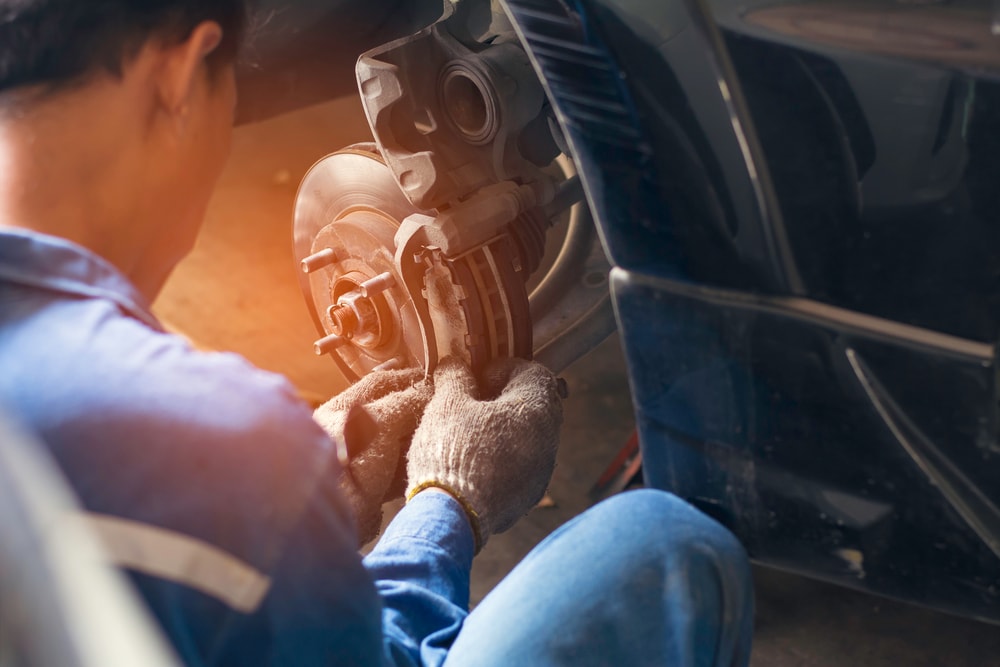
The ear-piercing cry of a worn-down brake pad needs immediate attention, but arranging a convenient service time isn’t always easy in the middle of a busy week. Thankfully, a simple brake pad change often only takes about 30 minutes to an hour. And if you have the resources and a DIY attitude, you may be able to save time and money by handling the project yourself.
If you try to tackle brake pad changes, appreciating the importance and complexity of your brake system is critical. Brake pads are only one part of an effective system. While swapping them out is often the key to restoring braking power, there’s more to consider to optimize your vehicle’s performance. We’ll explain how long it takes to change brake pads and discuss various factors that can affect their longevity.
How Long Does It Take to Change Brake Pads?
If you only change your brake pads, it will take about 30 minutes to one hour to complete the job. Each wheel requires two brake pads, which pop in easily enough after you remove the wheel and disassemble the caliper. But you can’t change only one pair at a time, and there’s more to look at while you have the wheel off other than the brake pad.
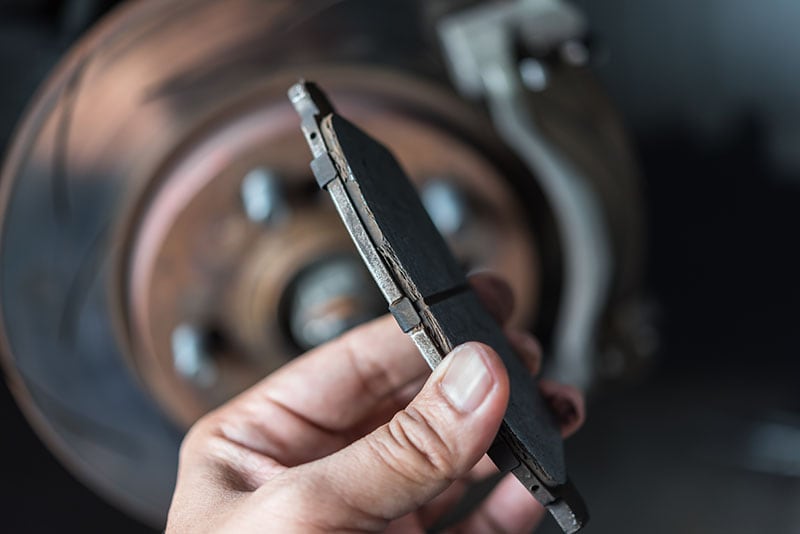
Change Brake Pads in Pairs (Front or Rear)
You should replace both sets of brake pads, either the front pads or rear pads, at the same time. If your front left wheel’s brake pads are down to the wear indicator and the right wheel’s brake pads still have a few more miles to go, you have to swap them both.
Changing only one set of brake pads can cause uneven and potentially hazardous wear. When a new brake on one side of the car engages more firmly than a nearly worn-down brake pad on the other side of the vehicle, the car can swerve dangerously to one side.
Check for Damage
While changing your brake pads, you may discover needed adjustments or repairs to make on additional brake components. Some may be minor, such as replacing the brake pad clips. Resolving other faults, including a warped rotor or damaged caliper, can be more challenging and time-consuming.
Test Drive
After changing the brake pads, you’ll also want to test them on a short drive before hitting the main drag. At the auto shop, your mechanic will do a test drive for you, adding to the total time for brake pad service.
How to Change Brake Pads
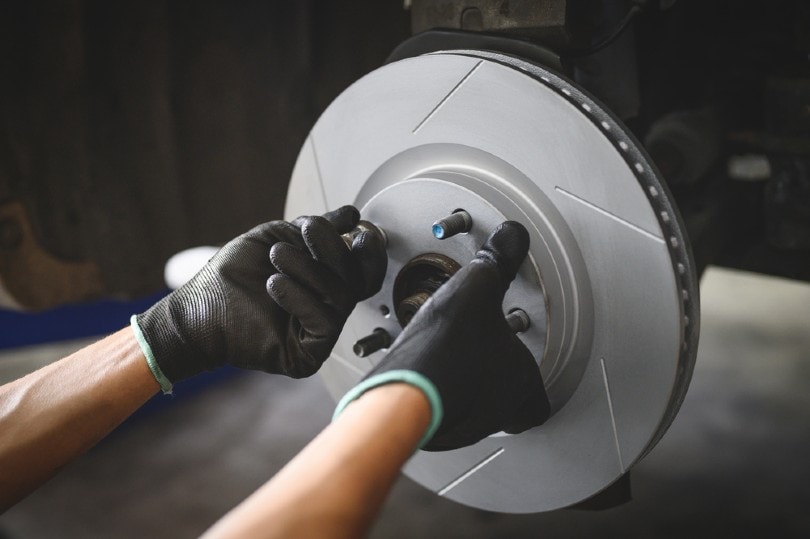
Changing brake pads only requires a few simple tools and materials to accomplish.
- Loosen the lug nuts on the affected wheels (front or rear) with a tire iron
- Use a floor jack to elevate the vehicle
- Position jack stands to hold the vehicle and remove the jack
- Remove the lug nuts from the tire and set aside
- Pull off the tire and place it out of the way (the rotor and brake calipers are now exposed)
- Use a ratchet to remove the caliper bolts on the interior of the caliper
- Carefully place the caliper on top of the rotor to hold it out of the way and prevent strain on the brake line
- Use a flathead screwdriver to pop out the old brake pad clips and brake pads, paying attention to the orientation of the pieces
- Push the caliper piston back into place with a brake depressor so that the new, thicker brake pads will fit into the caliper
- Install new clips and brake pads
- Reassemble the caliper and attach the tire
Throughout the process, preventing stress on the brake line is crucial to avoid damage. Use bungee cords to suspend the caliper if you need to remove it. You can make changing the front brake pads easier by turning the steering wheel to expose the interior caliper hardware.
Checking the rotors and cleaning as you go will help your new brake pads and the rest of the brake components operate efficiently. You can also take the opportunity to grease the caliper guide pins and brake pad parts. Applying an anti-seize compound to the back of the new brake pad shims and along the clips will prevent vibrations, noises, and underperformance. Never use lubricant on the brake pad face or rotor, as it will reduce stopping friction.
FAQ
How Much Does It Cost to Change Brake Pads?
If you change only the pads and do the work yourself, it can cost $30–$100 to replace a front or rear set of disc brakes. The cost will vary according to the car’s specifications and the pad type, with organics being the cheapest and ceramics the most expensive. At the mechanic, labor costs of $80–$120 will bring the total to around $110–$220 per axle.
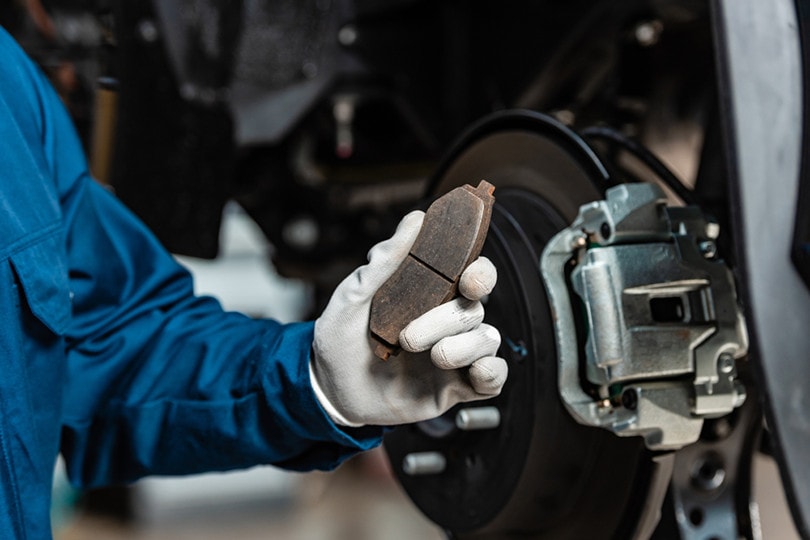
How Do I Know My Brake Pads Need a Change?
With typical use and good braking habits, the sound of the wear indicator will be the first sign that your pads need a change. Once it hits the wear indicator and emits a powerful squeal when you apply the brakes, the brake pad only has limited wear material left before you reach the backing plate.
Damaged brake pads that haven’t reached the wear indicator will need premature replacement. Glazing is a common cause of pad damage. Overuse or aggressive braking will make the pad overheat, causing it to harden into a smooth, shiny surface.
A glazed pad will have reduced stopping power and potentially damage the rotor. It will also be more susceptible to pitting and cracking. If you notice your braking distance is lengthening or the brakes are squeaking or vibrating when you slow down, you should check the condition of your pads and rotors.
How Often Do You Need to Change Brake Pads?
Brake pads can last 25,000–80,000 miles before needing replacements. An essential factor in determining their longevity is the composition. Inexpensive organic brake pads are the softest and will wear out the fastest of any brake pad type. Semi-metallic brake pads will outlast organics, and top-end ceramic pads deliver the lengthiest lifespan.
Regardless of the type of brake pads you use, driving habits and environmental factors will affect their longevity. For example, hard braking and riding the brakes will wear the pads much quicker than slow, smooth stops. Rough driving conditions, such as long mountain descents and uneven terrain, can also increase the stress on the brake system, as will city driving with frequent stops.
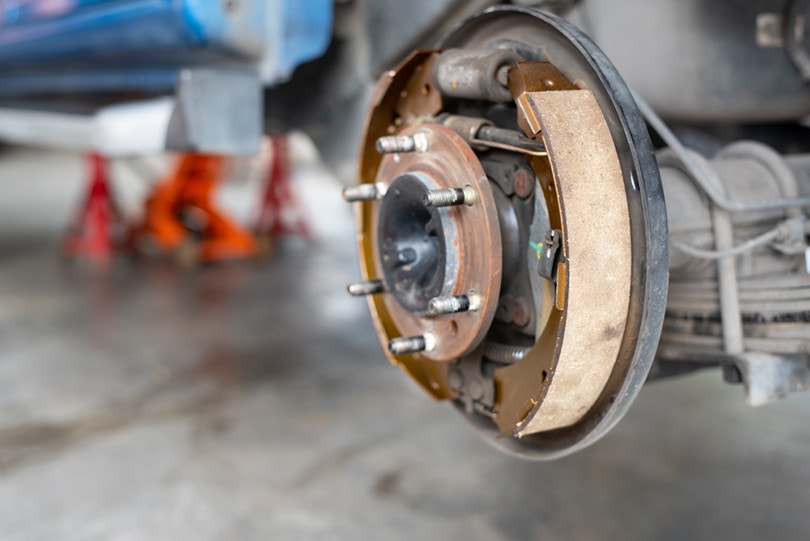
How Long Does It Take to Change Drum Brake Pads?
Drum brakes are less common on newer vehicles, but you may find your older car has this alternative brake style in the back wheels. Replacing them can take a little longer than replacing a disc brake, and the cost of new shoes is similar to that of brake pads. Brake shoes need replacement after 30,000–40,000 miles, while drums typically need replacements every 150,000–200,000 miles.
Final Thoughts
Changing your brake pads may cost about 30 minutes out of your day and around $70 from your wallet, but it’s well worth the investment. Brake failure isn’t often the cause of accidents on the road, but when it happens, the results can be life-changing. Keep your ears tuned for the sounds of brake pad wear, and don’t hesitate to take those few minutes of maintenance that will ensure the safety of everyone on the road.
See also:
- How Long Do Brake Pads Last? What Factors Affect Longevity?
- DO YOU HAVE TO BLEED BRAKES AFTER CHANGING PADS?
Featured Image Credit: CC7, Shutterstock
Contents


